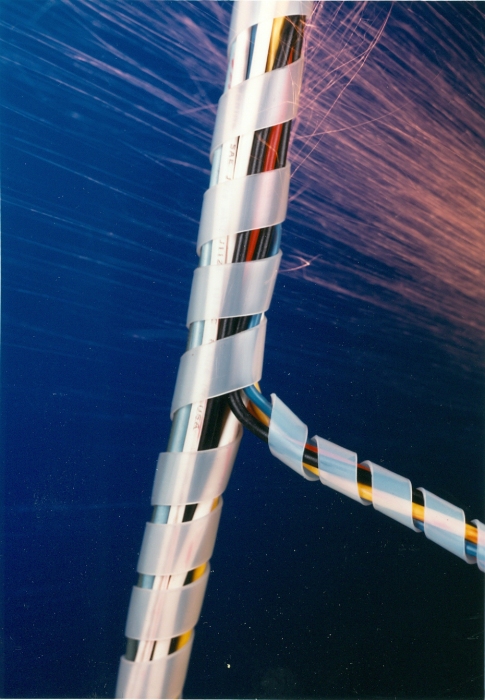
Spiral wrap – known also as spiral cable wrap, spiral wrap tubing or spiral wire wrap – serves a number of important purposes. One key function of spiral wrap is to protect wires or hoses against abrasion. However, unlike other methods for protecting cables or hoses, due to its design spiral wrap also enables easy maintenance and repairs as it allows easy access to individual cables or hoses.
For protecting cabling, spiral wrap is often used for computer networks, in electronics, with control systems and for other electrical applications that require organizing and protecting multiple cables. Spiral wrap hose protectors are used widely in the automotive industry, with robotics and in other hydraulic applications to protect industrial hosing from abrasion.
How Spiral Wrap Protects Against Abrasion
Spiral wrap adds another layer to cables or hoses to give them an additional layer that allows them to better resist abrasion. Besides their abrasion resistance, spiral wrap protects cables or hoses from physical damage due to crushing, cuts or impact.
Advantages of using spiral wrap to protect against abrasion include:
- Allows single or multiple cables or hoses to be led out from a bundle.
- Comes in a variety of colors to enable easy identification of bundles.
- Depending on the application, it can be made from a variety of materials.
- Enables several cables or hoses to be bundled together.
- Simple to install.
Installing Spiral Wrap for Protecting Cables & Hoses
The ease with which spiral wrap is installed around wires or hoses makes it a particularly useful implement for protecting bundled cables or hoses against abrasion. While not requiring any tools itself, installing spiral wrap hose protectors properly involves a simple understanding of how spiral wrap works. The more space there is between spirals, the more flexible the hoses or wires will be, while the closer the spirals are together, the less flexible they’ll be. Conversely, the closer together the spirals are, the better their abrasion resistance, while the further apart they are, the less resistant to abrasion they’ll be.
Here are some simple steps on how to install spiral wrap:
- Measure the outer diameter of bundled hoses or cables.
- Choose spiral wrap that’s smaller than the bundled hoses or cables so that it won’t slip.
- Cut spiral wrap to length.
- Begin wrapping spiral wrap around the bundle, working from one end to the other.
- While wrapping, route any hoses or cables needed outside the bundle.
If it’s necessary to reroute hoses or cables, removing spiral wrap is just as simple as installing it.
Spiral Wrap: Cable Protector Applications
Commonly used in office environments, spiral wrap is used to help organize cabling in office environments for electronic equipment and in hard-wired IT networks. Spiral wrap cable protectors also help prevent damage due to abrasion, crushing or other physical pressure. It’s particularly useful as it allows single cables or wires within a bundle to be drawn out to reach specific equipment.
Their flexibility allows cabling greater freedom to bend and move while keeping them organized and protected. They’re also sometimes used for bike cables, limiting pressure or abrasion to cables around the handlebar. Household uses for spiral wrap include keeping people from tripping over cables, damaging them when moving bundles or even preventing curious pets from chewing on the cabling. Their flexibility makes them useful for any application that involves protecting bundles of electrical cable.
Spiral Wrap: Hose Protector Applications
Spiral wrap hose protectors can be used to protect a wide variety of hydraulic, pneumatic and other industrial hose assemblies used in factories and on construction sites. For hoses that need to move about, spiral wrap offers an excellent way to manage bundled hoses while protecting them from abrasion. Certain types of heavy-duty spiral wrap are even used in the mining industry, protecting hosing in underground environments.
Many industries use spiral wrap. Hose protectors are commonly used in the auto industry to protect bundles of hydraulic hoses from abrasion and punctures, while also neatly organizing them. In many industrial settings, bundles of hoses need to be moved around during production. As these hose bundles are often dragged across factory floors, spiral wrap not only protects the hosing but also extends its life cycle.
Best Spiral Wrap Hose Protector Material
The material out of which spiral wrap hose protectors are made will differ depending on the application. They can be composed of nylon, polyethylene or PTFE, with certain types that resist fire as well as abrasion.
Spiral wrap hose protectors can be made from the following:
- Nylon spiral wrap provides excellent abrasion resistance, while it also has self-extinguishing qualities and can even be made resistant to ultraviolet light; used to protect hydraulic hoses in industrial settings from abrasion, nylon is widely used within the auto industry in engines.
- Polyethylene spiral wrap offers the lowest cost, though it doesn’t stand up well in heat; certain types of polyethylene spiral wrap can be fabricated to resist fire or ultraviolet radiation, so can be used outdoors without degrading.
- PTFE spiral wrap works well in high-temperature applications, offering the widest range of operating temperatures; it’s inflammable and chemically inert, along with being abrasion resistant.
Another benefit spiral wrap offers is the wide variety of colors in which it comes, which can help with organizing cables or hoses.
Spiral Wrap by M.M. Newman Corporation
M.M. Newman Corporation makes and sells its own spiral wrap to protect cables and hoses from abrasion. Heli-Tube® spiral wrap can be tailored to a customer’s specifications, with custom lengths along with made-to-order diameters, pitches and wall thicknesses. To learn more about the various uses of spiral wrap, hose protectors or cabling organizers, contact M.M. Newman Corporation today.

